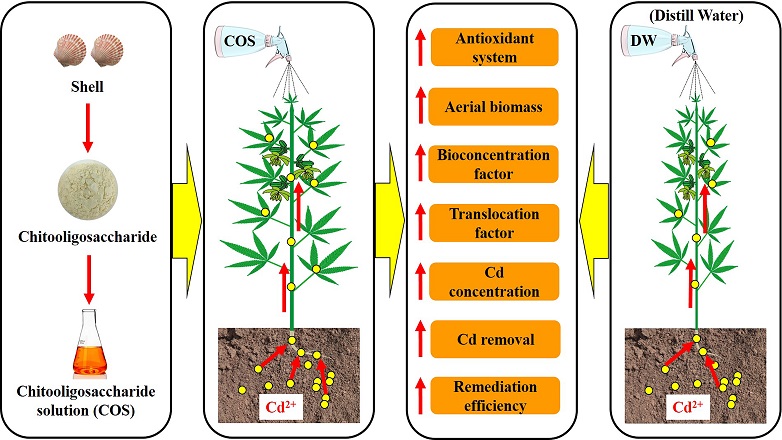
Recently, the Green Low-Carbon Production Technology Innovation Team from the Institute of Bast Fiber Crops, Chinese Academy of Agricultural Sciences (IBFC, CAAS) put forward a new method of improving the phytomanagement efficiency of industrial hemp using chitosan oligosaccharide.
Hemp features multiuse, high economic value, Cd tolerance, and high biomass, making it a suitable candidate for phytoremediation. However, the remediation efficiency of hemp is unsatisfactory and should be further improved. This evaluated the performance of different chitosan oligosaccharides (COS, NACOS, and HTCOS) with two application doses (45 and 90 μL m-2 of 500 mg L-1 mother solution) on the growth and phytoremediation efficiency of hemp. Finally, we found that chitooligosaccharide notably influenced the production of antioxidants and aerial biomass (increased by 84% maximum). COS (at lower doses and Cd contamination), NACOS, and HTCOS significantly elevated the Cd concentration in hemp plants. Consequently, NACOS and HTCOS at a higher dose significantly increased the average Cd removal reaching up to 61% and 81%, respectively, compared with the control. Hence, chitooligosaccharide enhanced the growth and phytoremediation efficiency of hemp by elevating the aerial biomass and anti-adversity capability.
This work was supported by the Agricultural Science and Technology Innovation Program (ASTIP-IBFC-04) the European Union’s Horizon 2020 Research and Innovation Program (101006873, GOLD project—www.gold-h2020.eu) the Natural Science Foundation of Hunan Province (2024JJ6449), and the Natural Science Foundation of Changsha Municipal (kq2402190).

Fig. A schematic diagram: Foliar application of chitosan oligosaccharides promotes the growth and phytomanagement efficiency of industrial hemp
This study titled Chitooligosaccharide application enhanced the growth and phytoremediation efficiency of industrial hemp in Cd-contaminated soils has been published online in Bioresource Technology and can be accessed through the link : https://doi.org/10.1016/j.biortech.2024.131998.

